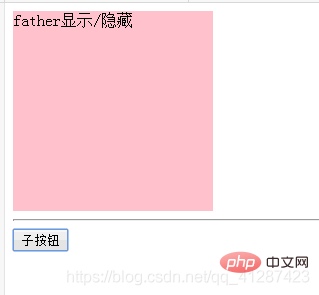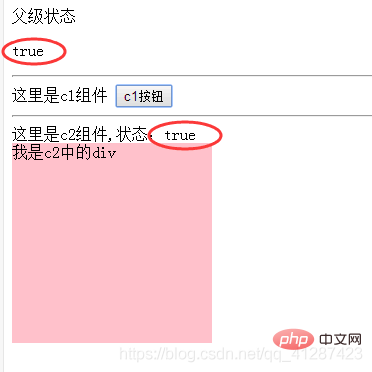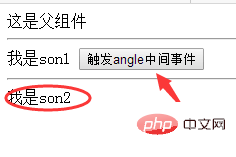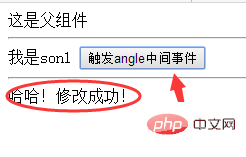vue组件传值的五种方法:1、父组件向子组件进行传值;2、子组件向父组件进行传值;3、相邻兄弟组件间进行传参;4、远兄弟组件间进行传参;5、EventBus传参。

本教程操作环境:windows7系统、vue2.9.6版,DELL G3电脑。
Vue的通信方式,也可以说是传参方式:
-
父组件向子组件进行传值:
-
子组件向父组件进行传值:
-
相邻兄弟组件间进行传参(亲兄弟)
-
远兄弟传参(表兄弟)
-
EventBus传参
一、父子传参
原理:父控制子,通过子组件的props属性,抛出子组件自定义标签属性,来接收父组件的操作状态
例子:父级里的一个按钮,控制子组件里的一个p的显示隐藏
<!DOCTYPE html> <html> <head> <meta charset="UTF-8"> <title>Document</title> </head> <style> .div{ width:200px; height:200px; background:pink; } </style> <body> <!-- 这里的app范围就是 子组件son 的父级 --> <div id="app"> <button @click='change'>父按钮</button> <hr> <!-- ********** 自定义标签属性test,接收父级的state ************--> <son :test='state'></son> </div> <template id="tp1"> <div> <!-- ************ 调用自定义属性test **************--> <div v-show='test'>我是子组件的div</div> </div> </template> <script src="../vue/vue.js"></script> <script> // 局部定义 子组件son new Vue({ el:"#app", data:{ state:true }, methods:{ change(){ this.state = !this.state; } }, components:{ son:{ template:"#tp1", //*********** 抛出自定义标签属性 *************** props:['test'] } } }) </script> </body> </html>
效果:

二、子父传参
原理:子控制父,子组件绑定自定义事件,来处理父组件的方法函数,通过.$emit(‘自定义事件’,[参数])来触发属于自己的自定义事件
例子:子组件里一个按钮,控制父组件里的一个p的显示隐藏
<!DOCTYPE html> <html> <head> <meta charset="UTF-8"> <title>Document</title> </head> <style> .div{ width:200px; height:200px; background:pink; } </style> <body> <div id="app"> <c1></c1> </div> <!-- 父组件c1 子组件c2 子组件自定义事件test--> <template id="c1"> <div> <div v-show='state'>father显示/隐藏</div> <hr> <!--************ 子组件c2自定义事件,执行父组件c1的方法函数change_f ***************** --> <c2 @test='change_f'></c2> </div> </template> <template id="c2"> <div> <button @click='change_son'>子按钮</button> </div> </template> <!-- 引入Vue.js框架文档,可在官方文档下载--> <script src='../vue/vue.js'></script> <script> //全局定义 // 实例化 父组件c1 Vue.component("c1",{ template:"#c1", data(){ return { state:true } }, methods:{ change_f(){ this.state = !this.state; } } }) // 实例化 子组件c2 Vue.component("c2",{ template:"#c2", methods:{ change_son(){ // ************ 在子组件方法里,触发子组件自定义事件 ****************** this.$emit("test") } } }) //实例化一个Vue对象 new Vue({ el:"#app" }) </script> </body> </html>
效果:

三、相邻兄弟传参(亲兄弟)
原理:通过一个公有的父元素作为桥接(实例 组件),结合父子props 传参 、子父自定义事件
例子:c1、c2是兄弟关系 c1可用控制c2里元素的显示隐藏
<!DOCTYPE html> <html> <head> <meta charset="UTF-8"> <title>Document</title> </head> <style> .div{ width:200px; height:200px; background:pink; } </style> <body> <div id="app"> 父级状态 <p>{{state}}</p> <hr> <c1 @test_c1='change_f'></c1> <hr> <c2 :test_c2='state'></c2> </div> <template id="c1"> <div>这里是c1组件 <button @click='change_c1'>c1按钮</button> </div> </template> <template id="c2"> <div>这里是c2组件,状态:{{test_c2}} <div v-show='test_c2'>我是c2中的div</div> </div> </template> <script src='../vue/vue.js'></script> <script> Vue.component("c2",{ template:"#c2", props:['test_c2'] }) Vue.component("c1",{ template:"#c1", methods:{ change_c1(){ this.$emit("test_c1") } } }) new Vue({ el:"#app", data:{ state:true }, methods:{ change_f(){ this.state = !this.state; } } }) </script> </body> </html>
效果:

四、远兄弟传参(表兄弟)
原理:通过创建一个中间实例,注册一个事件,在被控组件中,通过事件携带要执行的函数,在主控组件中,通过事件,改变相应的操作

<!DOCTYPE html> <html> <head> <meta charset="UTF-8"> <title>Document</title> </head> <body> <div id="app"> <father></father> </div> <template id="father"> <div> 这是父组件 <hr> <son1></son1> <hr> <son2></son2> </div> </template> <template id="son1"> <div> {{name}} <button @click='click_son1'>触发angle中间事件</button> </div> </template> <template id="son2"> <div> {{name}} </div> </template> <script src='../vue/vue.js'></script> <script> //********** 创建一个angle实例,作为中间变量(全局) ************** let angel = new Vue(); new Vue({ el:"#app", components:{ father:{ template:"#father", components:{ son1:{ template:"#son1", data(){ return { name:"我是son1" } }, methods:{ click_son1(){ // *************** 通过angel注册的test事件,修改son2中name的值 ************ angel.$emit('test','哈哈!修改成功!') } } }, son2:{ template:"#son2", data(){ return { name:"我是son2" } }, methods:{ change(val){ this.name = val; } }, //生命周期,自动执行,组件准备ok就可用 mounted(){ // *************** 通过angel注册的test事件,将son1的修改方法传过去 ************ angel.$on('test',this.change) } } } } } }) </script> </body> </html>
效果:
点击前:

点击后:

五、EventBus传参
1.在main.js种挂载全局EventBus
Vue.prototype.$EventBus = new Vue()
2.A组件
<template> <div class="wrap"> <div>我是组件A</div> <button @click="sendMsg">发送</button> </div> </template> <script> export default { name: "A", methods:{ sendMsg(){ this.$EventBus.$emit('sendMsg',"这是组件A发送的消息!") } } } </script>
3.B组件
<template> <div> <div>我是组件B</div> </div> </template> <script> export default { name: "B", mounted(){ this.$EventBus.$on('sendMsg',(msg)=>{ console.log(msg);//这是组件A发送的消息! }) }, } </script>
通过挂载全局Vue对象传递参数。
 站长资讯网
站长资讯网